

| Tiffany Lopez and Liesl Schauer | Spring 2001 |
| History 1302 | Hines |
|
Our town was originally founded in 1881 and was known as Fernando but now is know as LaCoste. It was named after French Businessman Jean LaCoste because he invested in the area. In early LaCoste, the economy centered on the railroad and farming. Now, LaCoste's economy is based on farming. LaCoste has managed to escape from major natural disaster damage for the most part. In May 1958, LaCoste was hit by a tornado. It caused structural damage to roofs, hen houses, trees, barns, businesses, and the school house. The tornado hit during the day while school was in progress, tearing off the second floor of the school house. Most students managed to escape with only minor scratches and one boy, Gus Pimentel, was hit in the head with a falling brick. The estimated damages to the town totaled $225,000. More recently LaCoste suffered minor flood damage in November 2000.
The local landmarks of LaCoste are the Swan & Railway Country Inn, Our Lady of Grace Church, City Hall, Rihn's Place, and the LaCoste Ledger. The local events of LaCoste are the Our Lady Of Grace Church Festival in June and the Fall Festival at Medina Valley Intermediate School sponsored by The LaCoste Garden Club. Prior to the 1970s, LaCoste had no sewer systems and water systems. Electricity and a few paved roads came earlier. The townspeople had to take their own trash to the local dump. The French settled in LaCoste first, then the Hispanics followed suit. In the public school system, predjudice against Hispanics was common, but in the Catholic school system, predjudice was unheard of. Prejudice in LaCoste isn't what it used to be. The racial tensions are now non-existent, but passing through the town, looking at who lives where, you wouldn't be able to tell. The town seems to be divided by the railroad tracks, mostly Anglos on one side and mostly Hispanic on the other. A mere 50 years ago, the one building, public school house was a vessel for young minds to be taught to dislike, to even hate, and to expand that feeling. Students who couldn't speak English were set apart, taken to a tiny separate room until they learned the language. Nowadays the students play with whoever, and are encouraged to do so. The children are untouched by the racial tensions that ran so freely just a few generations before. Interview Questions: 1) How long has your family lived in LaCoste (how many generations?)2) What kinds of major changes have you seen the town go through? 3) Tell us about the house you grew up in. 4) Did you go to school in LaCoste? 5) What was school like? 6) How does the effects of the railroad differ from today than from then? 7) Has your family influenced the town? If so, how? Interview of Joyce Rihn Joyce Rihn has lived in LaCoste since 1960. She has seen the town grow in many different ways. Some of these ways are: garbage pickup, sewer lines, and the town being declared a town. Her home was old and had seven rooms for a family of 10. She did not go to school here, but went in Devine. The railroads today have no cabooses, and back then trains were used to sell local farm goods. Joyce Rihn now works at LaCoste National Bank, and her family has helped LaCoste grow and prosper. Interview of Roberta Lopez Roberta Lopez's roots in LaCoste started with her father. Her family has lived here since 1939. The railroad used to stop in the town to load and unload cattle and goods. The train also used to stop for passengers, and the train used to have a pole to hold a sack of mail so the conductor could grab it on the way by. LaCoste used to have grocery stores, dry goods stores, and a mercantile. When the railroad stopped stopping in LaCoste, many businesses failed. LaCoste had few paved roads, and citizens had to go to the local dump to dispose of their garbage. Roberta grew up in a small three bedroom house that sheltered nine people. The house had no running water, electricity, or sewer systems. Her first five years of school were spent at Our Lady of Grace Catholic School, where all the old buildings were later knocked down and replaced. The nunnery is where the priest currently resides, and the Parish Center is where the priest used to live. The Catholic School had no predjudice. Roberta later went to the local public school, where predjudice was common. Spanish speaking students were separated into a separate small room where they were taught English. Roberta Lopez doesn't think her family has really influenced the town in a particular way except for helping the population to increase.
Tiffany is tied to the community because many of her relatives reside in LaCoste. She feels that small towns are great because the are quiet and peaceful. Liesl, on the other hand, is not related to anyone in LaCoste but her immediate family. She also enjoys living here because it seems safer than living in San Antonio and she is comfortable. LaCoste is said to have no future prospects. It's a dying farming community with few businesses to tax for city funds. Many of the farming families are large, so the farm can only be passed down to certain members of the family; because of that, many people from the families found gainful employment in San Antonio and switched professions. There is an oil refinery in LaCoste the city could tax and it could create local jobs, but the townspeople don't want to reopen it because of the fire hazards. |
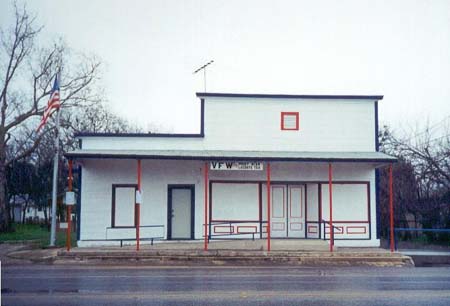 |
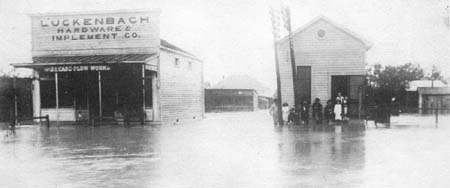 |
Flooding has always been a part of life in LaCoste. This photo, circa 1920's, shows a dog and a horse stranded on the steps of Luckenbach's Hardware and Implement Co., and a crowd stranded on the steps of the LaCoste Telephone Co. Luckenbach's son Everett remembers that Louis Luckenbach opened his hardware and implement company about 1913. He had the building constructed for $450. Louis was the agent for J.I. Case Tractors and he was also the town gunsmith. When Louis was out demontrating his Case tractors and implements, Everett recalls that his mother Keannie would mind the store. After the Louis Luckenbach family moved from LaCoste in 1922, the LaCoste Ledger occupied the building until the mid-1940's. In 1947-48, the LaCoste V.F.W. Post 8134 purchased the building for $3000.00 (Echoes of the Past) |
|
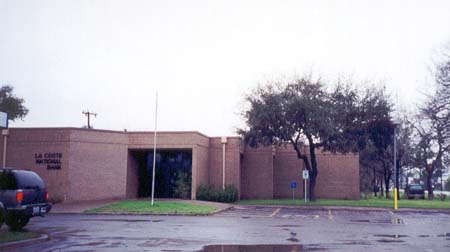 |
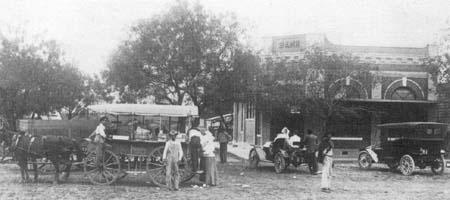
|
A street vendor peddles his wares, on South Front Street, in front of LaCoste National Bank. The bank was founded in March of 1912 with a capital stock of $25,000. Joseph Courand was President, Emil Schmidt Vice President, and H.C. Heilig was Cashier. By 1916 the total assets had passed the quarter of a million dollar mark -- "a good index to the frugality, enterprise and worth of the people hereabouts" (LCL 9-29-16). Conservative banking practices have kept the bank solvent, even during the depression when other banks failed. (Echoes of the Past) |
|
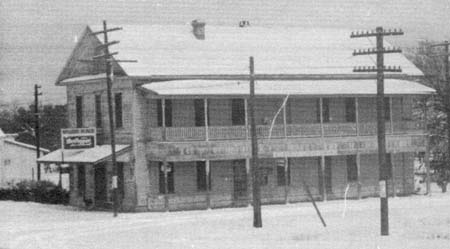 |
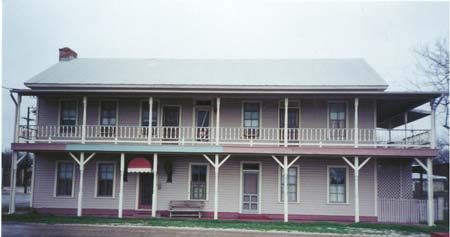 |
| In 1912, the Hondo Times reported "that the new hotel being built in LaCoste by Emil Schmidt is progressing very rapidly." It provided overnight rooms and eating facilities for the public. In 1915 Mrs. Mayme Tanner was running the hotel, followed by various proprietors including Mesdames M. Segler and N. Segler of Lylte in 1916. Mr. and Mrs. W.H. Hensley 1916, Mr. and Mrs. Whitman in 1917, and then the Henry Biedigers, followed by the Frank Biedigers in 1919. Gus and Margaret Mary (Maggie) Keller purchased the hotel in 1928, and even though it was prohibition, the Kellers allowed drinking and gambling in a back room. Irene Salzman recalls that the beer/whiskey was made in the basement of the Bill Keller (Gus's brother) Store. In later years, visitors to the bar would notice that the walls and ceiling of the bar were covered with bottle caps. This began in an effort to keep the wallpaper from sagging and continued until all the walls and ceilings were covered. Keller's Place remained open until after Maggie's death in 1976. In the 1980's it was converted into a bed and breakfast. (Echoes of the Past) |
|
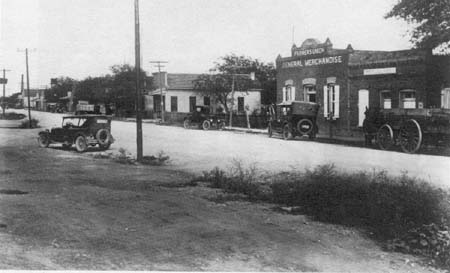 |
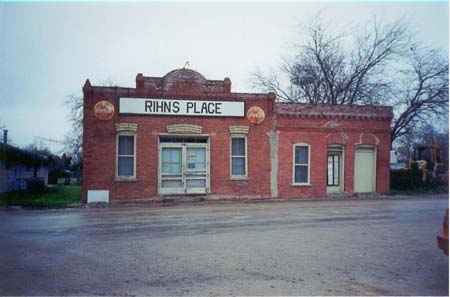
|
This view of South Front Street shows the businesses that were there in the early 1920s. The Farmer's Union had moved into the Schmidt and Gross Building in 1917. At that time Henry Haas was President of the Farmer's Union, H.F. Wurzbach was Vice President, O.J. Wurzbach was Secretary/Treasurer, and R.J. Mangold was the Manager. In March of 1929 the Farmer's Union closed and held its "going out of business sale". Then in May of the same year Mr. and Mrs. Edmund Keller moved into the building with the Krueger Implement Co. and a Handy Andy Grocery Store. Laura Reicherzer worked for the Kellers for a number of years, and she remembers that the store sold everything from small farm implements and work clothes, to farm fresh eggs and homemade butter from local customers. The bacon, ham, sausage, and lard were also homemade. Laura also recalls that there were pens in the rear of the store, where you could stable livestock for short periods of time when necessary. In 1941, the Handy Andy Grocery Store closed and sold its inventory to the LaCoste Mercantile. Dick Rihn opened Dick's Place, a beer parlor, here in 1944. Today it is known as the Rihn's Place (Run By Dick's son Jerome). At the time of this photo Geo. L. Haas had a Meat Market in the west half of this Building. (Echoes of the Past) |
|
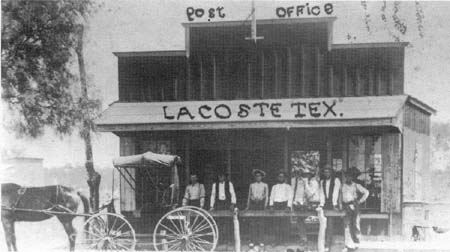 |
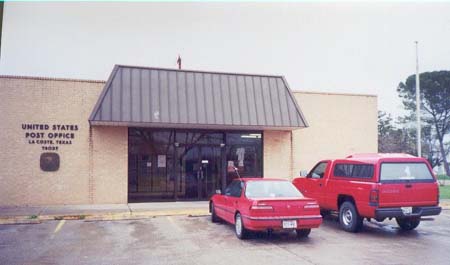 |
| This unidentified group of men stands in front of the LaCoste Post Office in 1909. The man on the left without a hat and wearing sleeve garters is probably the post master Gustave Moeller. Although the Idlewild Notes in a Castroville Anvil of 1895 refer to Mr. Loessberg (as) the new merchant of our sister post office, LaCoste, "the National Postal Archives do not indicate a post office here until May 23, 1898, and that Mrs. James M. Cook was the first postmaster. Other local records showed that by January 1902, Mr. Martin Braden was serving as Postmaster. In 1907, Gustave C. Moeller was appointed followed by Alex E. Jungman in 1911. Mr. Frank R. Dickey served from 1914 until Alex Jungman was re-appointed in 1917. In 1956 Mr. Jungman retired and Mr. Lloyd Keller assumed the position of LaCoste Postmaster. For a period around the turn of the century, mail and official documents unexplainably used the names LaCoste and Fernando interchangeably to designate the community. (Echoes of the Past) |
|
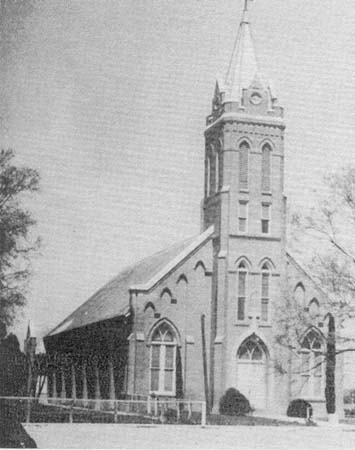 |
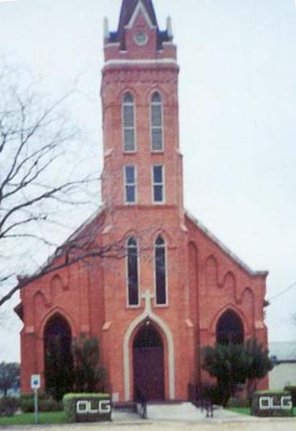 |
In 1924, Our Lady of Grace Church was enlarged, the Sanctuary and sacristies added, and the steeple was completed. Today the exterior of the church is virtually unchanged from this period. (Echoes of the Past) |
|
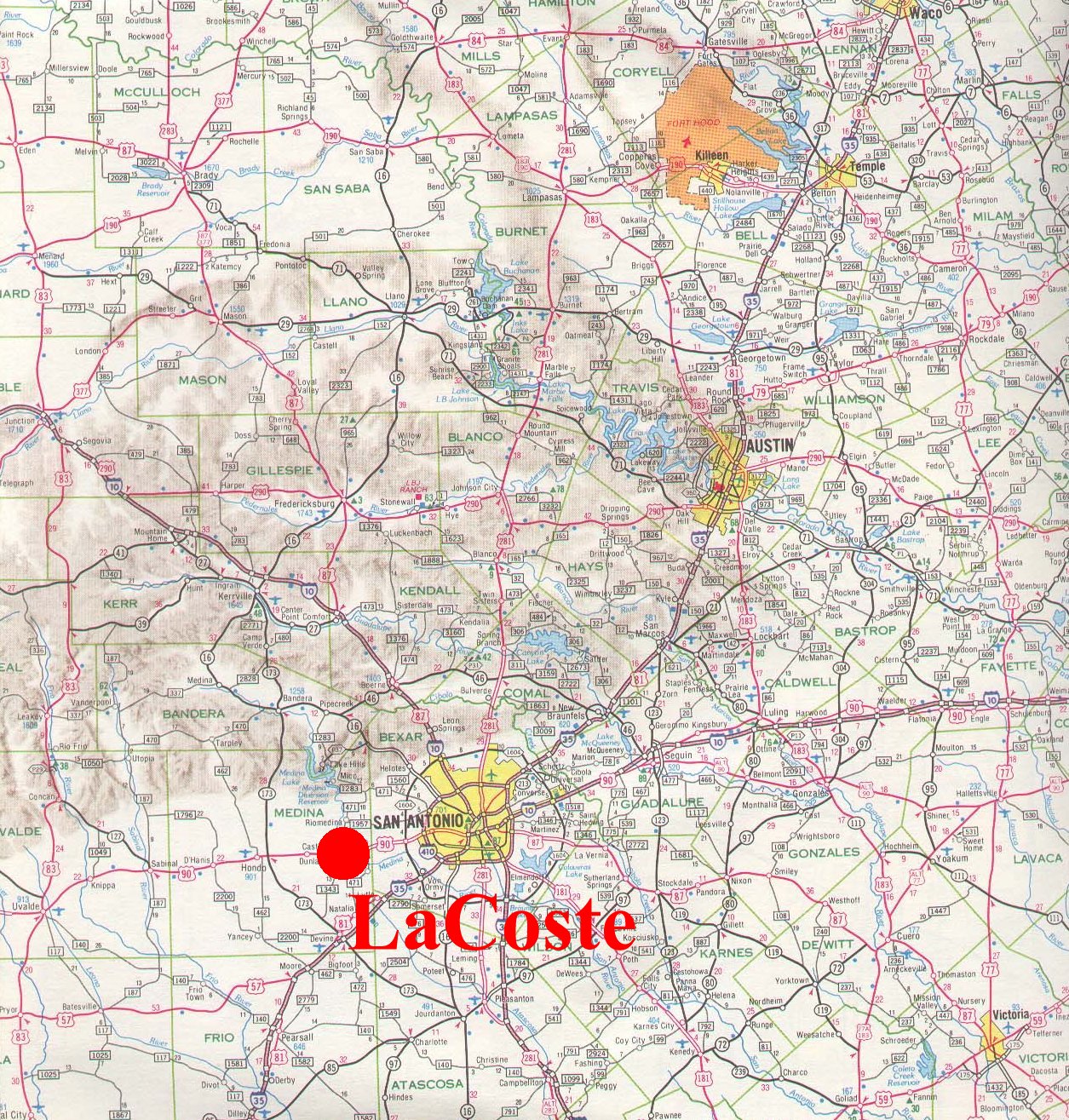
WEBSITES:
Handbook of Texas Online: LaCoste
ANNOTATED BIBLIOGRAPHY:
Biediger Cheryll, Echoes of the Past, The LaCoste Garden Club, 1996
We used this book for pictures, and information about the town.
Lopez Roberta, Interview
We talked to Roberta to get a more personal view of the town.
Rihn Joyce, Interview
We interviewed Joyce to get a more personal view of the town.
Ron Tyler, The New Handbook of Texas Volume 3, The Texas State Historical Association, 1996
We used this book to gathered general information on the town.
http://www.tsha.utexas.edu/handbook/online/articles/print/LL/hll6.html
We gathered information about the early LaCoste and its development from this site.